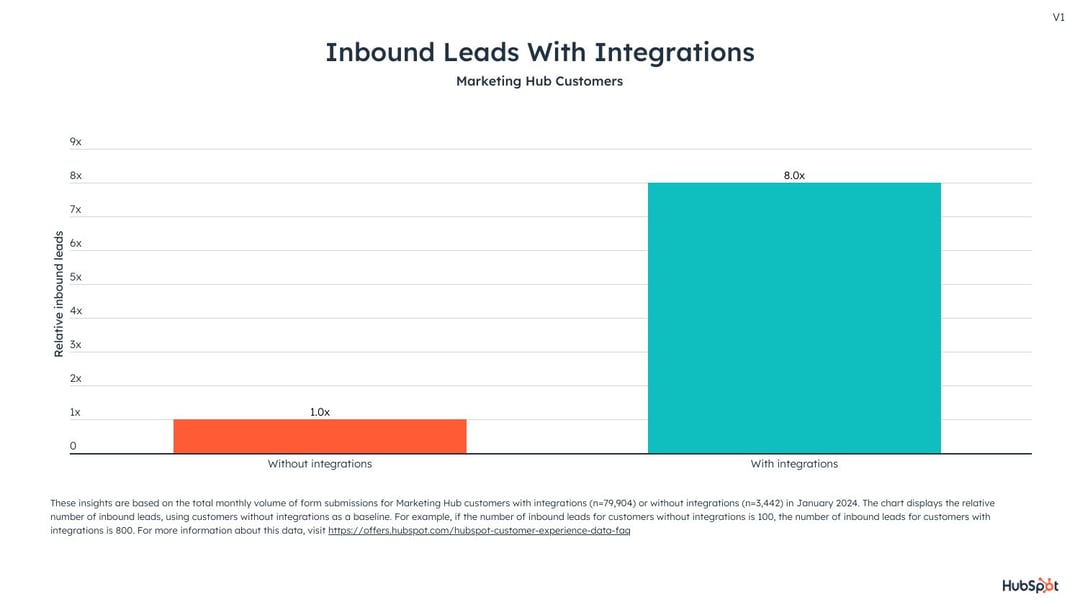-
8x
Marketing Hub customers with integrations see 8x the number of inbound leads as customers without integrations.

Building marketing engagement quickly
In 2021, Ramp had no marketing engagement system in place, and there was no centralized platform for sending email, Head of Marketing Technology Austin Hay tells us. “There's a million different reasons why somebody can get lost in the funnel, and we were missing out on the opportunity to reengage them without an email marketing tool,” Austin says.
That’s not surprising when you consider Ramp’s rapid growth trajectory. “By the time most companies get to the size and stage of Ramp, they already have an email tool,” Austin says. “But Ramp grew so quickly that we went from not needing a tool to needing an enterprise-grade marketing tool very quickly.”
A flexible tool for enterprise growth
Ramp needed an email and marketing engagement tool that had the enterprise functionality to support them on their rapid growth journey, without being overly complex for their team. “We needed something that was lightweight enough that any one of our team could just go in and use it, but robust enough that it was going to be able to scale to a large enterprise with us over the next several years. That’s a really hard balance,” Austin says.
With the right marketing tool, Ramp’s marketing team would be able to reengage leads that had dropped out of the funnel. “We didn’t have a single tool, system, and methodology for how we wanted to send emails and build our marketing program,” Austin says. “Choosing an enterprise tool would help us clarify that. With the right tool, we would be able to invest in our marketing program in a way that would be sustainable as we grew.”
After comparing several options, Ramp chose HubSpot Marketing Hub for its extensive B2B functionality, ability to scale, and vast integration library.
Getting the most from their data
Once Ramp implemented Marketing Hub, they were quickly able to set up a comprehensive contact management and email marketing strategy. But it was HubSpot’s integrations that allowed them to enhance the platform, connect it to the tools they use most, and most importantly, get insights into their data they wouldn’t otherwise have access to.
“Email marketing on its own is not useful if you don’t understand the impact of what you’re doing,” Austin says. “It’s bad tool management if you’re forced to use a single tool for all of the things you need to do. If we couldn’t use our integrations to look at our email marketing data outside of HubSpot, it would be detrimental to our marketing program. There’s a lot of stuff that our data scientists are going to want to do on their own, outside of the tool. HubSpot’s integrations give us the flexibility to understand our data and act without being constrained to the format the tool provides.”
Bi-directional Salesforce integration
Ramp uses HubSpot’s bi-directional Salesforce integration to synchronize the attributes of objects with analogous attributes in Salesforce. “Salesforce is not a very elegant CRM,” Austin says. “It’s tried and true, but something as simple as getting attributes from a person to a person object in Salesforce requires a lot of work. For a complicated business like ours, where we have a CDP at the top of the funnel and we're tracking behavioral data and events that people perform on the website, it would be fairly complicated to directly send that data to Salesforce.”
With the HubSpot-Salesforce bi-directional integration, Ramp uses the synchronization tool to get all of their data into HubSpot, which then syncs with Salesforce. “It creates a nice, elegant stream of data. The top of the funnel collects all the data. It synchronizes with HubSpot. HubSpot synchronizes with Salesforce, which Salesforce puts in the warehouse. That's really valuable, especially for businesses that don't have a lot of engineering resources,” he says.
A valuable app ecosystem
With Hightouch, Ramp can take model data from their warehouse and stream it into other tools. It allows them to take models they’ve created for non-real time user behavioral data, create new attributes, and stream those attributes back into HubSpot, where they can use them for different marketing campaigns or triggered emails. “That’s probably one of our most used integrations,” Austin says. “We’re always adding new data to HubSpot in order to send email campaigns.”
They use the Amplitude integration as an alert monitor in HubSpot. It’s set up for both ad-hoc analysis and real-time alerts when campaigns change or the number of sent emails go down. “Both of those together allow us to evaluate and understand our data in a near real-time way,” Austin says.
Ramp also uses HubSpot’s Livestorm integration to build an end-to-end funnel for all of their events and webinars and use that intelligence to build workflows and automations to send emails based on webinar attendance. Finally, Ramp uses the Fivetran integration to pull data out of HubSpot and into their Snowflake warehouse, which allows them to do all of their modeling in-house.
Reaching engagement goals
By leveraging several Marketing Hub integrations, Ramp has reached their engagement goals for leads, helping to fuel their continued rapid growth.
They’ve been able to consolidate insights and use that information to inform everything from strategic decisions to sales tactics. “It changes a salesperson’s perspective to know that a possible prospect opened an email for a specific product. They know there’s interest there, and they would know that person has engaged before. It changes the way they would approach that account,” Austin says.
For Austin, Marketing Hub’s integrations are the key to making the most of the platform. “Why wouldn't you make use of the tool you're already paying for?” he asks. “HubSpot integrations are designed to make it easy for you to extract and ingest data into and out of HubSpot. Using your data where you need it most is the way most operators want to run their stacks today, and HubSpot leans into this principle with Marketing Hub.”

.jpeg?width=120&height=120&name=Copy%20of%20Austin_Hay_2022%20(1).jpeg)

.png?width=215&height=50&name=Lendio_Logo%20(1).png)


.png?width=215&height=50&name=LS-Logo@4x%20(1).png)

.png?width=215&height=50&name=Ignite%20Logo%20(1).png)

%20(1).png?width=215&height=50&name=Fusion_Logo_Vert_4c_RGB%20(2)%20(1).png)
